Measurement of Static Electricity Generated from Contact and Separation of Clothes and Car Seat Covers
Shoush K. A., Mohamed M. K., Zaini H. and Ali W. Y. Faculty of Engineering, Taif University, Al –Taif, SAUDI ARABIA.
Abstract-Measurement of static electricity is of critical importance in assessing the proper electric properties of car seat covers and their suitability to be used in application to enhance the safety and stability of the driver. The present work aims to measure the static electric charge generated from the contact and separation of materials used as car seat covers and clothes. Different materials of car seat covers and clothes were tested to measure the voltage generated from electric static charge .It was found that voltage generated by the contact and separation of the tested upholstery materials of car seat covers against the materials of clothes showed great variance according to the type of the materials. The materials tested showed different trend with increasing load. The contact and separation of the tested against polyamide textiles generated negative voltage, where voltage increased down to minimum then decreased with increasing load. The behaviour can be interpreted on the fact that as the load increased the two rubbed surfaces, charged by free electrons, easily exchanged the electrons of dissimilar charges where the resultant became relatively lower voltage. High density polyethylene displayed relatively lower voltage than cotton and polyamide textiles, while polypropylene textiles displayed relatively higher voltage than that shown for high density polyethylene. The variance of the voltage with load was much pronounced. Voltage generated from polyester textiles showed reasonable values. Remarkable voltage increase was observed for contacting synthetic rubber. This observation can limit the application of synthetic rubber in tailoring clothes.Based on the experimental results the materials of car seat covers can be classified according to their electric properties. Materials of high static electricity can be avoided and new materials of low static electricity can be recommended.
Keywords-Electric static charge, voltage, cotton, polyester, textiles, upholstery materials, car seat covers, triboelectrification
————————————————————
T
INTRODUCTION
he wide use of polymer fibres in textiles necessitates to study their electrification when they rubbing other surfaces. The electric static charge generated from the friction of different polymeric textiles sliding against cotton textiles, which used as a reference material, was discussed, [1]. Experiments were carried out to measure the electric static charge generated from the friction of different polymeric textiles sliding against cotton under varying sliding distance and velocity as well the load. It was found that increase of cotton content decreased the generated voltage. Besides, as the load increased voltage generated from rubbing of 100 % spun polyester specimens increased. Besides, mixing polyester with rayon (viscose) showed the same behavior of mixing it with cotton. Generally, increasing velocity increased the voltage. The voltage increase with increasing velocity may be attributed to the increase of the mobility of the free electrons to one of the rubbed surfaces. The fineness of the fibres much influences
the movement of the free electrons.
The electrostatic charge generated from the friction of polytetrafluoroethylene (PTFE) textiles was tested to propose developed textile materials with low or neutral electrostatic charge which can be used for industrial
application especially as textile materials, [2]. Test specimens of composites containing PTFE and different types of common textile fibers such as cotton, wool and nylon, in a percentage up to 50 vol. % were prepared and tested by sliding under different loads against house and car padding textiles. Ultra surface DC Voltmeter was used to measure the electrostatic charge of the tested textile composites. The results showed that addition of wool, cotton and nylon fibers remarkably decreases the electrostatic discharge and consequently the proposed composites will become environmentally safe textile materials.
Research on electrostatic discharge (ESD) ignition hazards of textiles is important for the safety of astronauts. The likelihood of ESD ignitions depends on the environment and different models used to simulate ESD events, [3]. Materials can be assessed for risks from static electricity by measurement of charge decay and by measurement of capacitance loading, [4]. Tribology is the science and technology of two interacting surfaces in relative motion and of related subjects and practices. The popular equivalent is friction, wear, and lubrication, [5]. Tribological behavior of polymers is reviewed since the mid-20th century to the present day. Surface energy of different
coatings is determined with contact adhesion meter. Adhesion and deformation components of friction were discussed. It was shown how load, sliding velocity, and temperature affect friction. Different modes of wear of polymers and friction transfer were considered, [6]. The ability to engineer a product’s tactile character to produce favorable sensory perceptions has the potential to revolutionize product design. Another major consideration is the potential for products to produce friction-induced injuries to skin such as blistering, [7, 8]. Sports activities may cause different types of injuries induced by friction between the skin and sport textiles. Focusing on runners who are often bothered with blisters, the textile–foot skin interface was studied in order to measure and predict friction. The characteristics of mechanical contacts between foot, sock and shoe during running were determined. It was found that textiles with conductive threads did not give ignitions provided they were adequately earthed, [9]. When isolated, all textiles were capable of causing ignitions regardless of the anti-static strategy employed.
Friction coefficient displayed by clothes sliding against car seat covers was discussed, [10]. The frictional performance of two groups of covers, the first contained five different types of synthetic leather and the second contained nine different types of synthetic textiles, was measured. Measurement of friction coefficient is, therefore, of critical importance in assessing the proper friction properties of car seat covers and their suitability to be used in application to enhance the safety and stability of the driver. Less attention was considered for the triboelectrification of the textiles. Friction coefficient and electrostatic charge generated from the friction of hair and head scarf of different textiles materials were measured, [11]. Test specimens of head scarf of common textile fibres such as cotton, nylon and polyester were tested by sliding under different loads against African and Asian hair. The results showed that friction coefficient generated from the sliding of the cotton head scarf against hair displayed higher values than that showed by polyester head scarf. The nylon head scarf when sliding against hair showed relatively lower friction coefficient than that observed for polyester and cotton scarf. Electric static charge measured in voltage represented relatively lower values. This behaviour may be attributed to the ranking of the rubbing materials in the triboelectric series where the gap between human hair and nylon is smaller than the gap between hair and cotton as well as hair and polyester.
especially at lower loads. The nylon head scarf showed slight decrease in friction coefficient compared to scarf. The decrease might be from the difference in the weave form although the both two textiles are made of nylon. The weaves form has significant effect on friction coefficient and voltage generated.
Little attention has been devoted so far to the electrostatic properties of hair although these properties are very sensitive to the friction between hair and head scarf textiles. Hair has a tendency to develop static charge when rubbed with dissimilar materials like human skin, plastic and textiles. Human hair is a good insulator with an extremely high electrical resistance. Due to this high resistance, charge on hair is not easily dissipated, especially in dry environments. Many macroscale studies have looked at the static charging of human hair, [12 - 14]. Most of these studies include rubbing hair bundles with various materials like plastic combs, teflon, latex balloons, nylon, and metals like gold, stainless steel and aluminum. Hair in these cases is charged by a macroscale triboelectric interaction between the surface and the rubbing element. The kinetics of the charging process and the resulting charge are then measured using modified electrometers.
In the present work, the electric static charge generated from the contact and separation between surfaces of different polymeric textiles of car seat covers sliding against cotton and polymeric textiles used in manufacturing of clothes will be investigated.

EXPERIMENTAL
The electrostatic fields (voltage) measuring device (Ultra Stable Surface DC Voltmeter) was used to measure the electrostatic charge (electrostatic field) for test specimens, Fig. 1. It measures down to 1/10 volt on a surface, and up to 20 000 volts (20 kV). Readings are normally done with the sensor 25 mm apart from the surface being tested.
The specimens, of polymeric textiles, were prepared in strips of
Generally, at higher loads, the difference in friction values was insignificant. African hair displayed relatively higher
voltage. Nylon displayed relatively higher friction
50 mm width and 100 mm length. They were fastened on the surface of wooden plate of 50 × 100 mm2,
Fig. 1 Electrostatic
field measuring device.
coefficient than polyester when slid against human hair,
while cotton proposed the highest friction coefficient
Table 1. The upholstery materials of car seat covers were adhered to the wooden block of 50 × 50 mm2. Tests were
carried out at room temperature under 10, 12, 14 and device.16 N normal loads. The contact and separation were done manually. The electric static charge was measured by DC voltmeter.

Table 1 Test specimens.


3 RESULTS AND DISCUSSION
The results of the experiments carried out to measure the electric static charge generated from the contact and separation of the tested materials are shown in Figs. 2 –
13. Voltage generated by the contact and separation of the tested upholstery materials of car seat covers against cotton textiles is shown in Figs. 2 and 3. It is clearly shown that the amount of generated voltage showed great variance according to the type of the materials. The maximum voltage was 180 volts, while the minimum was 5 volts. The materials tested showed different trend with increasing load, where some showed no effect (D), while the others showed voltage increase with increasing load (A), (C) and (H). The rest showed that voltage increased
up to maximum then decreased with increasing load (B),
(E) and (G). Material (F) showed decreasing trend with
increasing load. The contact and separation of the tested materials against polyamide textiles, Figs. 4 and 5, generated negative voltage. This behaviour could be attributed to the location of polyamide in the triboelectric series. Polyamide gained positive charge, while the materials of car seat covers gained negative charge. The maximum value of the voltage reached -350 volts for material (H). Generally, voltage increased down to minimum then decreased with increasing load. This behaviour can be interpreted on the fact that as the load increased the two rubbed surfaces, charged by free electrons, easily exchanged the electrons of dissimilar charges where the resultant generated relatively lower voltage.

Fig. 2 Voltage generated by the contact and separation of the tested upholstery materials of car seat covers against cotton textiles.

Fig. 3 Voltage generated by the contact and separation of the tested upholstery materials of car seat covers against cotton textiles.
High density polyethylene surface, Figs. 6 and 7, displayed relatively lower voltage than cotton and polyamide textiles. The electrification of the tested materials was different for every material. The maximum value was 118 volts, while the minimum was 3 volts.

Fig. 4 Voltage generated by the contact and separation of the tested
upholstery materials of car seat covers against polyamide textiles.

Fig. 5 Voltage generated by the contact and separation of the tested upholstery materials of car seat covers against polyamide textiles.

Fig. 6 Voltage generated by the contact and separation of the tested upholstery materials of car seat covers against high density polyethylene surface.
Polypropylene textiles, Figs. 8 and 9, displayed relatively higher voltage than that shown for high density polyethylene, where the highest voltage reached 240 volts. The variance of the voltage with load was pronounced. The voltage increase might be attributed to the position of polypropylene in the triboelectric series, where it lies under polyethylene.
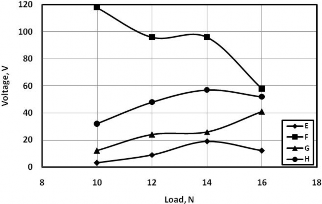
Fig. 7 Voltage generated by the contact and separation of the tested upholstery materials of car seat covers against high density polyethylene surface.
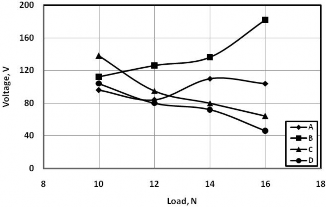
Fig. 8 Voltage generated by the contact and separation of the tested upholstery materials of car seat covers against polypropylene textiles.
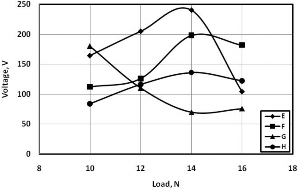
Fig. 9 Voltage generated by the contact and separation of the tested upholstery materials of car seat covers against polypropylene textiles.
Polyester has a wide application in the manufacturing of clothes. The highest voltage reached by polyester was105 volts for the tested material (A), Figs. 10 and 11. Except this material reasonable voltage values were measured for contacting polyester.
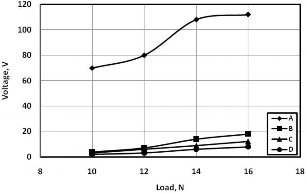
Fig. 10 Voltage generated by the contact and separation of the tested upholstery materials of car seat covers against polyester textiles.
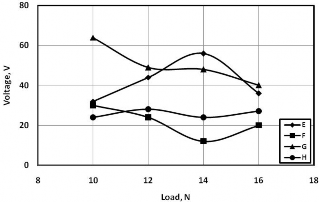
Fig. 11 Voltage generated by the contact and separation of the tested upholstery materials of car seat covers against polyester textiles.
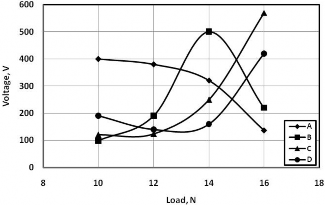
Fig. 12 Voltage generated by the contact and separation of the tested upholstery materials of car seat covers against synthetic rubber surface.
Remarkable voltage increase was observed for contacting synthetic rubber, Figs. 12 and 13. The highest voltage values reached 570 volts. The highest voltage generated from contact and separation was measured for synthetic rubber.
This observation can limit the application of synthetic rubber in tailoring clothes.
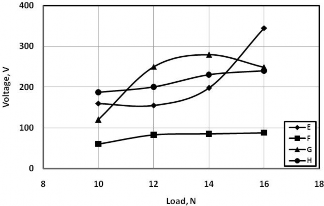
Fig. 13 Voltage generated by the contact and separation of the tested upholstery materials of car seat covers against synthetic rubber surface.
4 CONCLUSIONS
Voltage generated by the contact and separation of the tested upholstery materials of car seat covers against the materials of clothes showed great variance according to the type of the materials. The materials tested showed different trend with increasing load.
The tested upholstery materials of car seat covers against
polyamide textiles generated negative voltage. Voltage increased down to minimum then decreased with increasing load.
High density polyethylene displayed relatively lower voltage than cotton and polyamide textiles. The electrification of the tested upholstery tested materials was different for every material.
Polypropylene textiles displayed relatively higher
voltage than that shown for high density polyethylene. The variance of the voltage with load was much pronounced.
Voltage generated from polyester textiles showed
reasonable values.
Remarkable voltage increase was observed for contacting synthetic rubber. This observation can limit the application of synthetic rubber in tailoring clothes.
ACKNOWLEDGMENT
This study is financially supported by Taif University under a Contact No. 1-434-2349. The university is highly acknowledged for its financial support.
REFERENCES
[1]. Al-Qaham Y., Mohamed M. K.and Ali W. Y., "Electric Static Charge Generated From the Friction of Textiles", Journal of the Egyptian Society of Tribology Vol. 10, No. 2, April 2013, pp. 45 – 56, (2013).
[2]. Ibrahim R. A., Khashaba M. I. and Ali W. Y., "Reducing the Electrostatic Discharge Generated from the Friction of Polymeric Textiles", Proceedings of The Third Seminar of the Environmental Contaminants and their Reduction Methods, September, 26 – 28, 2011, AlMadinaAlMonawwara, Saudi Arabia, (2011).
[3]. Zhancheng W., Chen Y., and Xiaofeng L., Shanghe,
“Research on ESD ignition hazards of textiles”. J. of Electrostatics 57, pp. 203 – 207, (2003).
[4]. Chubb J., New approaches for electrostatic testing of
materials, J. of Electrostatics 54, pp. 233 – 244, (2002). [5]. Bhushan B., “Introduction - measurement techniques
and applications”, Handbook of Micro/Nanotribology, pp. 3 - 4, Boca Raton: CRC Press LLC, (1999).
[6]. Myshkin N. K., Petrokovets M. I., Kovalev A. V.,
“Tribology of polymers: Adhesion, friction, wear, and mass-transfer”, Tribology International, Vol. 38, pp. 910
- 921, (2005).
[7]. Matthew D. A., Christian S. J., “Investigation of skin
tribology and its effects on the tactile attributes of
polymer fabrics”, Wear, Vol. 267, pp. 1289 - 1294,
(2009).
[8]. Derler S., Schrade U., Gerhardt L. C., “Tribology of human skin and mechanical skin equivalents in contact with textiles”, Wear, Vol. 263, pp. 1112 - 1116, (2007).
[9]. Poopathy K., Michael T. J., Juk H., Paul H., Jan L.,
Gabriele S. L., “Measurements of incendivity of
electrostatic discharges from textiles used in personal protective clothing”, Journal of Electrostatics, Vol. 49, pp. 51 - 70, (2000).
[10]. Sulaimany A. A., AlGethami A. A. and Ali W. Y.,
"Friction Coefficient Between Clothes and Car Seat
Covers", Journal of the Egyptian Society of Tribology Vol. 8, No. 4, October 2011, pp. 35 – 46, (2011).
[11]. Al-Osaimy A. S., Mohamed M. K. and Ali W. Y., "Friction Coefficient and Electric Static Charge of Head Scarf Textiles", Journal of the Egyptian Society of Tribology Vol. 9, No. 3, July 2012, pp. 24 – 39, (2012).
[12]. Morioka K., “Hair Follicle-Differentiation Under the
Electron Microscope, Springer-Verlag, Tokyo, (2005). [13]. Bhushan B., LaTorre C., “in: B. Bhushan (Ed.),
Nanotribology and Nanomechanics - An
Introduction”, second ed., Springer, Berlin, (2008). [14]. Schroder D. K., "Semiconductor Material and Device
Characterization", third ed., Wiley, Hoboken, (2006).




















